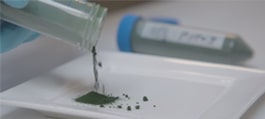

CleanAllAir air washers
for odor & air purification


CleanAllAir air washers
for odor & air purification


CleanAllAir air washers
for odor & air purification
Discharge water cleaning

Discharge water is used in both chemical air scrubbers and biological air scrubbers. Cleaning (and thereby reducing) discharge water in a biological manner is a hot topic. CleanAllAir responds to this by means of highly innovative (patented) techniques.
Blood water composition
The composition of discharge water differs per type of air scrubber. Biological combi-air scrubbers produce relatively much discharge water (10x more than chemical scrubbers) with low contents of substances that mainly consist of nitrogen (nitrate, (toxic!) nitrite and ammonium), and dust particles.
The composition of discharge water from chemical air scrubbers mainly consists of ammonium sulphate, nitrate and sulfur sulphate. The amount of discharge water from a chemical air scrubber is relatively low, but the concentration of nitrogen is high.
Drainage water as fertilizer
Discharge water, especially from chemical air scrubbers, has long been more than just a by-product and is increasingly used as nitrogen fertilizer. The advantages of discharge water as a fertilizer are numerous: it is sufficiently present, it limits the CO2 print and discharge water has the same effect as the old-fashioned fertilizer. However, there are also catches in the grass. The discharge of discharge water can have adverse effects on the environment and the Fertilizers Act must be complied with. As a result, drainage water cannot always be used as fertilizer. The latter is especially the case with discharge water from biological combi air scrubbers.
The most robust air washing systems
As they used to say:
“May cost nothing and never break”
Our systems are still running after 20 years!
Top Quality Service & Expertise
- Own breakdown service
- powerful & personal
- Literally the best in the market
Reduce and clean wastewater
If discharge water is not allowed to be discharged, disposal via a recognized collector is often the only option. It therefore remains important to develop and use innovative methods to reduce and clean up discharge water so that it can be reused. At CleanAllAir we apply the following methods:
1. Cleaning waste water by reverse osmosis (RO units)
CleanAllAir uses patented RO units for air scrubbers. By effectively applying reverse osmosis, the nitrogen-containing discharge water is split into clean water and a concentrate with nitrogen compounds. The clean water can then be reused in the air washer and the concentrate is discharged.
Reverse osmosis is an ideal method to significantly reduce water consumption. This is especially interesting for biological combi air scrubbers that produce large amounts of discharge water. Our RO system provides for this saving in a very efficient way without you having to worry about it yourself. We take care of the complete installation including service and maintenance for you.
2. Dissolving nitrogen
It needs no further explanation that reactive nitrogen has received a lot of attention within the Netherlands and Europe. All reactive nitrogen that can be demonstrably removed has a direct effect on all kinds of sectors in the Netherlands. Bio-Particles-International BV has developed a groundbreaking new method to convert high concentrations of nitrogen from discharge water from (biological) air scrubbers up to 99% into harmless N2. The unique and innovative cleaning process uses, among other things, the proprietary technology ‘MicRin’ (Microbial Removal of Inorganic Nitrogen). This allows the discharge water to be completely stripped of nitrogen. And the remaining water can be returned to the environment responsibly and without nitrogen. Through a collaboration with Bio-Particles-International, CleanAllAir can guide you in implementing this technique for you.
The nitrogen balance: simply demonstrating reduction
CleanAllAir offers the possibility to install a downstream technology in order not only to reduce the discharge water, but also to obtain a balanced nitrogen balance. In this way you can easily demonstrate how much nitrogen you have captured with the air scrubber and where it has been deposited. This way you can easily discuss a balanced and transparent nitrogen balance with the government.
